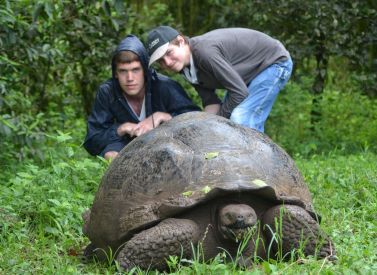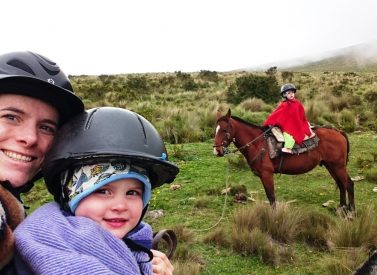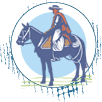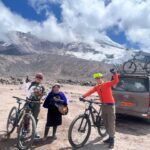
5-day Ecuador Family Holiday
Take the family on a 5-day multi-activity trip
Get active with our walking and horse-riding adventure holiday to the North of Ecuador.
Family travel to Ecuador helps you to experience and enjoy the way of life in this diverse Andean country, including discovering fascinating Afro-Ecuadorian communities.
On our Northern loop you hop along the iconic Equator line, visit Otavalo’s famous and vibrant market and visit a local community.
An array of activities including horse riding and walking are sure to keep the little ones busy, while you explore the culture and scenery.
More on family travel to Ecuador
This trip aims to provide the right balance of exploration and action for children of all ages.
At the same time there is plenty of opportunity for you to unwind at our child-friendly haciendas with plenty of games and entertainment to keep the kids happy.
We realise all children are different and can amend this itinerary to suit your family, including your favourite activities at the right level of action for your children.
Trip Highlights
Print Share Download as PDF-
Active tour for all the family, whatever your interests.
-
See condors, ride horses and hike to local communities.
-
Relax in evenings at lovely haciendas with plenty to occupy the kids.
-
Fully flexible itinerary to meet everyone's needs.
A fantastic experience that I would happily recommend to anyone interested and has left me with a taste for more.
M. Ackroyd, Ecuador
Full Itinerary
Day 1: Transfer Quito to north, via Equator and Condor rehabilitation centre, Hacienda
We set out from Quito, heading north into Ecuador’s scenic lake district. Our first stop is at the Quitsato Museum, where a unique sundial marks the Equator line. Here, you’ll have the chance to hop between the Northern and Southern Hemispheres and learn about this significant dividing line.
Continuing on, we visit the town of Cayambe, where local bakers create the famous bizcochos, a savory, flaky biscuit typically enjoyed with coffee, hot chocolate, cheese, or dulce de leche.
Next, we take in the beautiful views of San Pablo Lake, nestled beneath the Imbabura Volcano, before reaching Parque Condor, a rehabilitation center dedicated to birds of prey and condors. At this center (open Wednesday to Sunday), we’ll get up close with the impressive condors of the Andes and learn more about these mighty birds.
Our journey then leads us into lush cloud forest, where we stop at the sacred Peguche waterfall. We conclude our day at Hacienda Chorlavi, our home for the next four nights, where you can enjoy the swimming pool, gardens, and common areas—perfect for families.
Overnight Hacienda Chorlavi
Day 2: Excursion on horseback, Chachimbiro hot springs, Hacienda (B,L)
After breakfast, we’ll explore the countryside on horseback. We start our ride from a nearby hacienda (no experience required) and spend two hours traversing the picturesque farmland and communities of the Otavalo region. Here, you’ll see local agricultural practices and take in beautiful views framed by mountains and volcanoes.
Later, we are welcomed into the rural San Clemente community, where families share their indigenous traditions, beliefs, and culture. You’ll learn about medicinal plants, walk through their lands, and hear their stories. A traditional lunch is included with the community.
For those who prefer not to horseback ride, a full-day visit to the San Clemente Community can be arranged.
Overnight Hacienda Chorlavi
Day 3:Lago Yaguarcocha & City of Ibarra, Hacienda (B)
This morning we head to Lago Yahuarcocha near Ibarra, where a gentle walk along the lake offers scenic mountain views and activities for children, including play areas and lookouts.
We’ll also visit one of Ibarra’s historic ice cream parlors to see the preparation of “helados de paila,” a traditional handmade ice cream, and enjoy a taste.
The afternoon is free for your own activities.
Overnight Hacienda Chorlavi
Day 4: Morning walk, afternoon at leisure at Hacienda (B)
Day 5: Visit Otavalo market, return to Quito (B)
After breakfast, we say goodbye to Hacienda Chorlavi and start our return to Quito.
On the way, we’ll stop at Otavalo, known for its vibrant handicraft market, colorful textiles, and rich cultural traditions. Here, you can browse the market and soak up the lively atmosphere before we continue on to Quito, where you’ll be dropped off at your hotel.
Please note: Saturday and Wednesday are the busiest days, on other days the market is smaller which can make it easier for browsing.
Prices From $1,134 / £922 per person
What's Included?
English speaking guide, private transportation, accommodation in shared double & triple rooms, meals as listed (B=breakfast, L=lunch, D=dinner), excursions mentioned, entrance fee to Quitsato & Parque Condor, Train Tickets.
What's Not Included?
International flights, extra activities, spa treatments in Chorlavi, drinks, personal expenses, tips and insurance.
Accommodation
Hacienda Chorlavi is the base for this tour in the north of Ecuador.
The Hacienda is in a lovely location, ripe for exploring the local area.
There is also a bar, restaurant and small spa including a Jacuzzi.
Chorlavi also has a swimming pool, gardens and common areas as well as a large playground.
Tour Staff
You’ll be shown around by bilingual Ecuadorian guides with many years’ experience.
Our local drivers and support staff have worked with us for many years.
Staff employed at the lodges are generally from the local communities.
Meals
Almost all dietary requirements can be catered for – please ask us for more information.
Breakfasts at hotels will feature teas, coffees and juices to drink, plus cereals, fruit, eggs, toast and jams etc.
While out on tours and where lunch is provided, we either supply a packed lunch of sandwiches, snacks, soup, fruit etc, or we eat at a local restaurant/hacienda. These are often buffet style with soups, rice, pasta, potatoes and then puddings/fruit.
Our accommodation will provide evening meals. In general, it’s a soup for starters followed by an Ecuador inspired main dish – some international meals may be available at certain lodges.
Activity Level
Your trip is a private trip, making it a very flexible trip for you and your family.
The itinerary can be adapted to suit your preferences and needs and our guides are flexible and used to guiding families with children, so they know that sometimes plans for the day might change depending on the little ones.
Practical Information
Introduction to Ecuador
Ecuador is the second smallest South American country, and one of the most varied.
It comprises three main geographical areas: the coast, highlands and Amazon plus is home to the Galapagos Islands.
Because of its relatively compact size, it makes a great holiday destination as you can move from highlight to highlight fairly easily and rapidly.
Geography of Ecuador
Landscapes vary from the drier south to the more humid north.
The Highlands, or sierra, encompass two Andean Cordilleras (the Central and Western), which run north to south through the country. Ecuador’s largest volcano is Chimborazo (6,310m) whose summit, because of its proximity to the equator, is the closest point on earth to the sun. Several of Ecuador’s volcanoes are still active, and it’s a great area for trekking.
Descending the steep, east-facing slopes of the eastern Cordillera, one passes through a transition zone comprising dense cloud forest and humid high jungle, before entering the Amazon lowlands.
This mainly primary rainforest covers a third of the country, accounts for 5% of the population and stretches across Ecuador, from its Colombian to its Peruvian borders.
The Galapagos Islands are simply unique. Lying 600 miles off the mainland, the archipelago comprises the summits of gigantic equatorial volcanoes.
The flora and fauna of the Galapagos, long separated from their continental cousins, have evolved differently. Charles Darwin used his observations there to develop his theory of Evolution.
Weather in Ecuador
Ecuador lies between latitudes 4º south and 2º north. Overall, climate varies according to time of year, altitude and region.
The Sierra
In the Ecuadorian highlands, there is little temperature variation by season as temperature depends largely on altitude.
In Quito, shade temperatures range from 6 to 10ºC in the morning and from 19 to 23ºC in the afternoon, with cool nights. In the lower basins between mountains, it gets significantly warmer.
Rainfall depends on whether an area lies closer to the eastern or western Andes. To the west, June-Sept is the dry period and Oct-May the wet (with often a short, dry spell in Dec or Jan).
The best period to visit Quito and trek and climb volcanoes such as Cotopaxi is the west Andean dry season of June-Sept and Dec/Jan. This is also Ecuador’s high season. During the Oct-May wet season, most rainfall is in the afternoons.
To the east, Oct to Feb are dry and Mar-Sept are wet. Overall, the southern highlands are drier than the northern highlands.
The Coast
On the Pacific coast, rainfall becomes less from north to south. The coast can be enjoyed year-round, although from June-Sept mornings are often grey with the garua mists.
Jan-May is the hottest and rainiest time of year.
The Amazon
In Ecuador’s Amazonian region, rain can fall at any time, but Dec-March is usually the driest season and Mar-Sept is usually the wettest period.
The Galapagos Islands
Galapagos can be visited at any time of year.
The warm season is Jan-Jun, bringing calm, warm waters (around 70°F) and sunny days (72-9°F or 22-32°C), February and March being the hottest and sunniest months with blue skies and sunshine.
The islands receive slightly more rainfall during these months, occasional heavy bursts in the afternoon. Great for snorkelling and you can spend a lot of time in the water without wetsuits, with great, clear waters.
The dry ‘garua’ season is Jun-Dec an it’s a great time for marine life. August and September are the coolest when you may need a jacket in the evenings and the sea can be choppy and temperature drops around 15-24ºC on average.
There can be mist on the islands in the mornings (garua) which usually burns off by midday leaving overcast skies or a sunny afternoon.
Sea temperatures may drop to 60°F- 72°F (15-22°C) during this time and snorkellers will want a wet suit for prolonged periods in the sea.
Ecuador mainland climate
Ecuador lies between latitudes 4º south and 2º north. Overall, climate varies according to time of year, altitude and region.
In the Ecuadorian highlands, there is little temperature variation by season; this depends largely on altitude.
In Quito, shade temperatures range from 6 to 10ºC in the morning and from 19 to 23ºC in the afternoon, with cool nights. In the lower intermontane basins, it gets significantly warmer.
Rainfall depends on whether an area lies closer to the eastern or western Andes. To the west, June to Sept is the dry period and Oct to May the wet (with often a short, dry spell in Dec or Jan).
The best period to visit Quito and trek and climb volcanoes such as Cotopaxi is the west Andean dry season of June to Sept and Dec/Jan. This is also Ecuador’s high season. During the Oct to May wet season, most rainfall is in the afternoons.
To the east, Oct to Feb are dry and March to Sept are wet. Overall, the southern highlands are drier than the northern highlands.
Food and drink in Ecuador
On the coast
Ceviche de pescado Raw marinated fish, served with tostado (roasted maize).
Ceviche Popular everywhere, is best on the coast.
Ceviche de mariscos Marinated shellfish. Most varieties of shellfish ceviche – e.g. camaron (prawn) and langostino (king prawn) – are cooked before being marinated. The exception is ceviche de conchas (clams) which is marinated raw.
Langosta Lobster (Increasingly endangered, but is still fished illegally).
Empanada de verde Ground plantain pasty filled with meat, cheese or shrimp.
Sopa de bola de verde Plantain dumpling soup
Encocadas Dishes prepared with coconut milk. Can be shrimp, fish etc.
Patacones Fried plantain chips
In the Highlands
Locro de papas Potato and cheese soup.
Mote Burst maize.
Caldo de patas Cow-hoof soup (with mote).
Llapingachos Fried potato and cheese patties.
Empanada de morocho Ground maize shell filled with meat.
Sancocho de yuca Vegetable soup with manioc.
Cuy Guinea pig
Fritada/Chicharron Fried pork
Hornado Roast pork
Humita Ground maize meal wrapped in maize leaf and steamed (sweet or savoury).
Quimbolito Similar to humita, but made from maize flour and steamed in a banana leaf (sweet or savoury).
Drinks
Jugos Fruit juices are very good, including naranjilla, maracuya (passion fruit), tomate de arbol (tree tomato – like a sweet tomato) and piña (pineapple).
Aguardiente Unmatured rum (Cristal is nice). Also known as paico, trago and trago de caña.
Cerveza Lager-type beer is very popular. Several brands, including Pilsener and Club.
Ecuador’s Amazon rainforest
Some 40% of Ecuador’s and is covered by Amazon rainforest.
As well as being rich in wild life, Ecuador’s rain forest is still home to a multitude of indigenous tribes, some of which have opened their communities to ecotourism.
A 4 or 5-day visit to one of the quality lodges will allow you to venture into beautiful primary forest.
Native guides lead you on verdant forest trails where you will see monkeys, tortoises, frogs and an array of birds including toucans and macaws.
Large mammals like jaguar, tapir and giant anteater have been spotted, but are elusive.
Ecuador’s Cloud Forest
Ecuador’s cloud forest covers its rolling hillsides as they descend from the high Andean plateaus into the rain forest or down to the Pacific coast.
Most of this tropical forest lies between 1,200-2,700m/3,937-8,858ft above sea level, an evergreen, lush and moist forest, teeming with bird and insect life.
Much of the cloud forest is readily accessible from Quito making it perfect a 2 or 3-day stay.
There are many lodges with virgin forest, home to a dazzling variety of hummingbirds, refreshing waterfalls for swimming, zip lining and wildlife walks.
The humming birds, Cock of the Rock and the chance of spotting larger mammals such as the spectacled bears are just some of the attractions of spending some time in this amazing ecosystem.
Cotopaxi, Ecuador
Cotopaxi National Park is dominated by the almost perfect cone shape of Cotopaxi (5,897m/19,347ft), an active volcano and the second highest mountain in Ecuador after Chimborazo.
The national park is well worth a visit for trekking in the foothills, climbing smaller peaks like Ruminahui, downhill mountain biking, horse riding or just enjoying the National Park itself.
The surrounding páramo is good for bird watching – you may see condors soaring above.
There are lots of lovely hacienda and mountain refugios to stay at in and around the park, and from which there are a variety of walks, horse rides and bike rides for all levels.
Ingapirca Ecuador
Ingapirca (meaning wall of the Inca) is just an hour from Cuenca and is the most important Inca archaeological site in Ecuador.
The site is in good condition and consists of a main elliptical building thought to be a sun temple, with typical Inca features such as trapezoidal doorways and niches.
There are Inca trails leading to and from the site, so you can visit on a day trip or incorporate a visit as part of a trekking itinerary.
You can travel here from Cuenca, or make it part of a trip from Baños to Cuenca.
Quito, Ecuador
Ecuador’s vibrant capital Quito sits in a stunning location, surrounded by snow capped volcanoes and many of the high peaks of the Andean sierra.
There is plenty to do for visitors of all ages and interests. The old town of Quito is a UNESCO world heritage site, with many beautiful churches and colonial facades, a wonderful range of museums and picturesque squares.
For an over view of the city and along the Avenue of volcanoes to north and south and to help with acclimatising try taking the Teleferico (cable car) up the eastern slope of Pichincha volcano.
At night Quito is a lively city. Head to the modern Mariscal area where tourists and locals alike find a great range of restaurants, bars and night clubs.
Prices From $1,134 / £922 per person
2025 price, per person, shared room basis
Based on family of four
Upgrades available
Shorter/longer stays possible
Single supplements apply

Dates & Prices
Prices From $1,134 / £922 per person
2025 price, per person, shared room basis
Based on family of four
Upgrades available
Shorter/longer stays possible
Single supplements apply
Can’t find what you’re looking for? Get in Touch
+44 (0)131 378 5593
+44 (0)131 554 6025



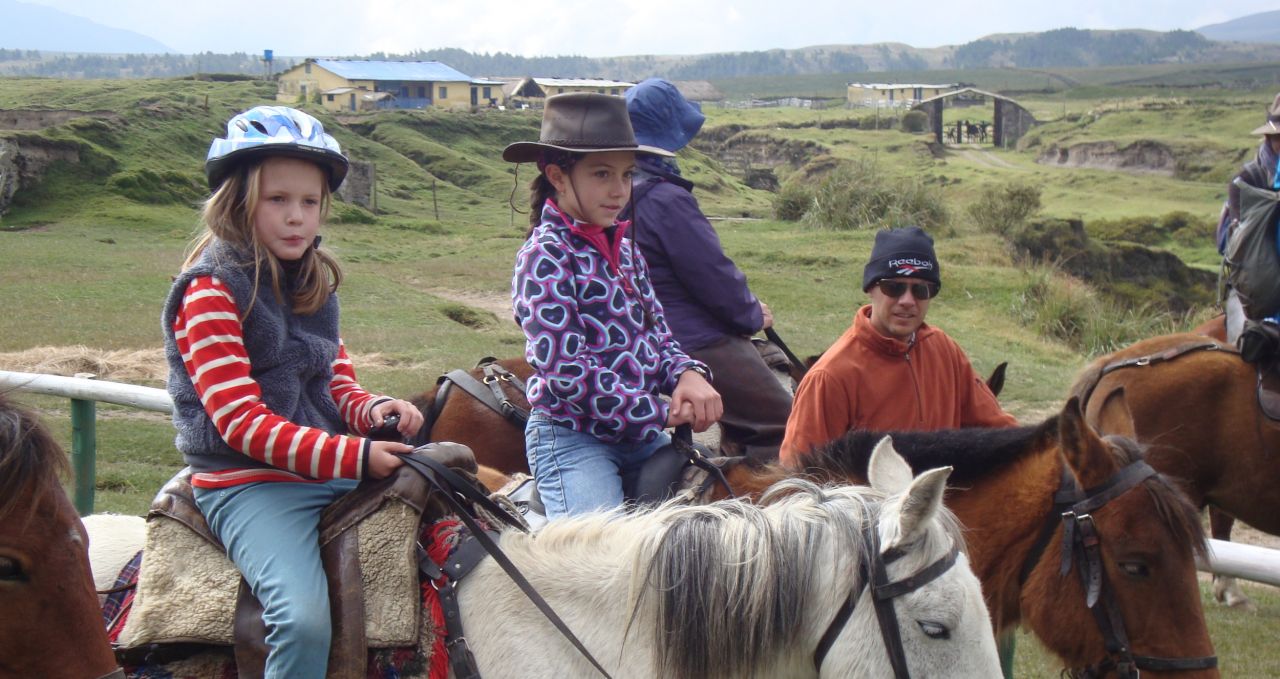
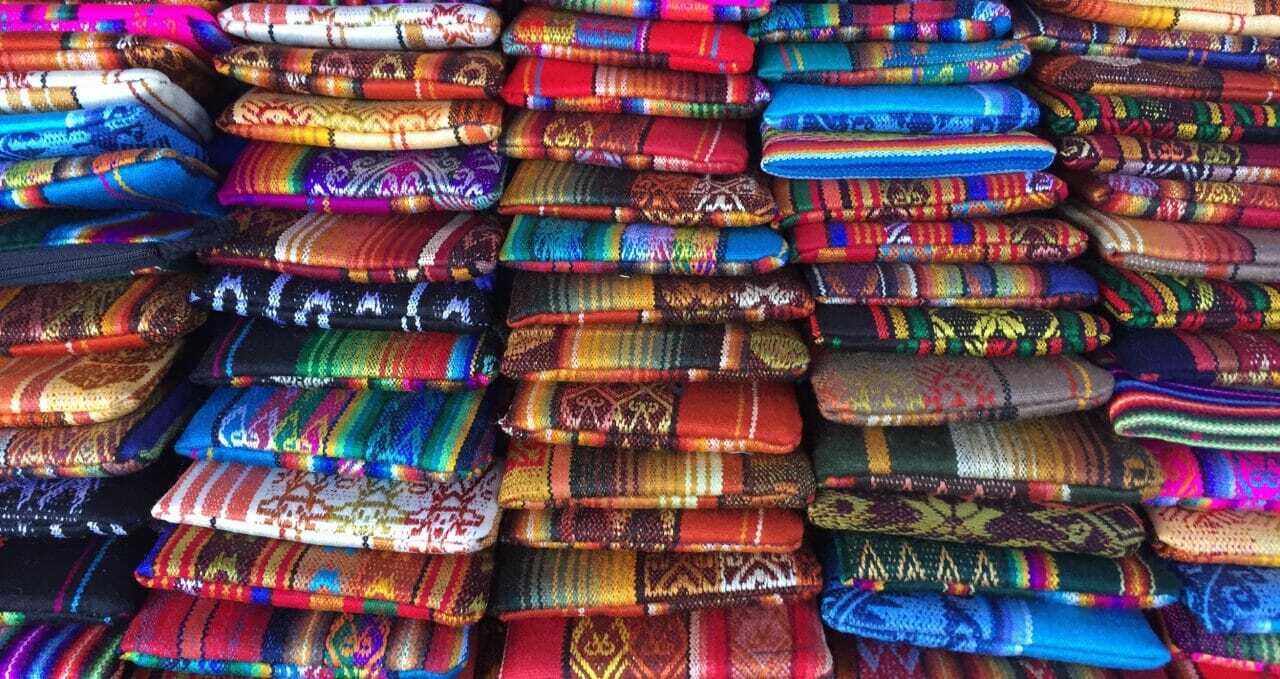
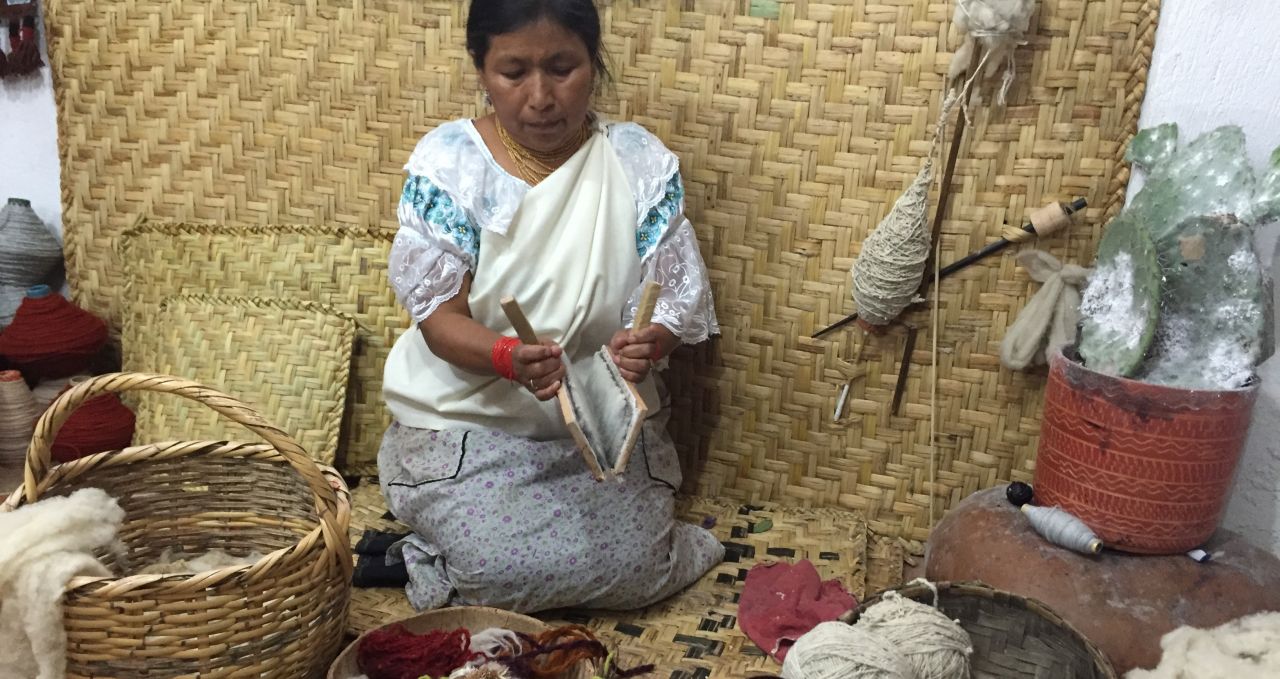
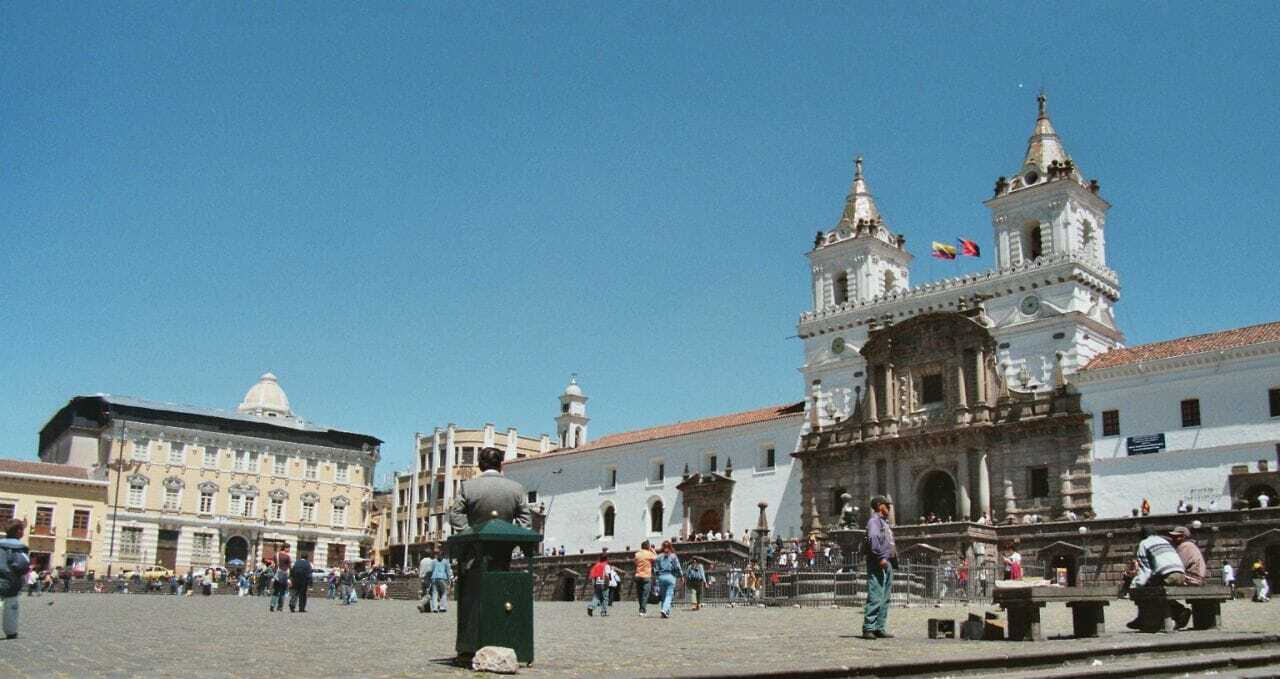
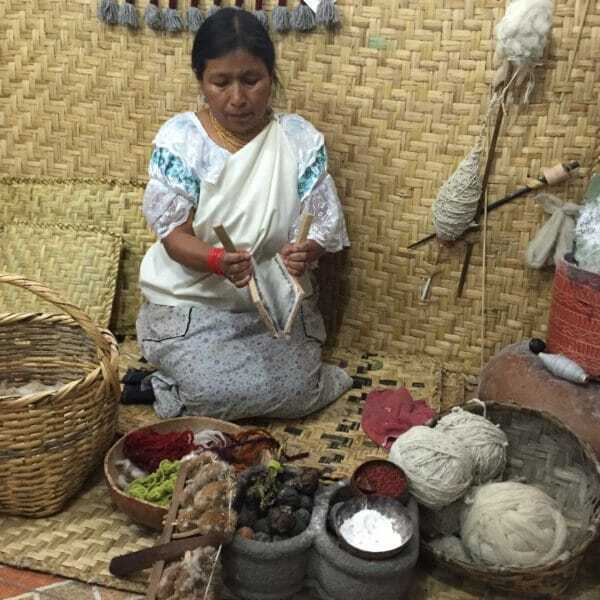
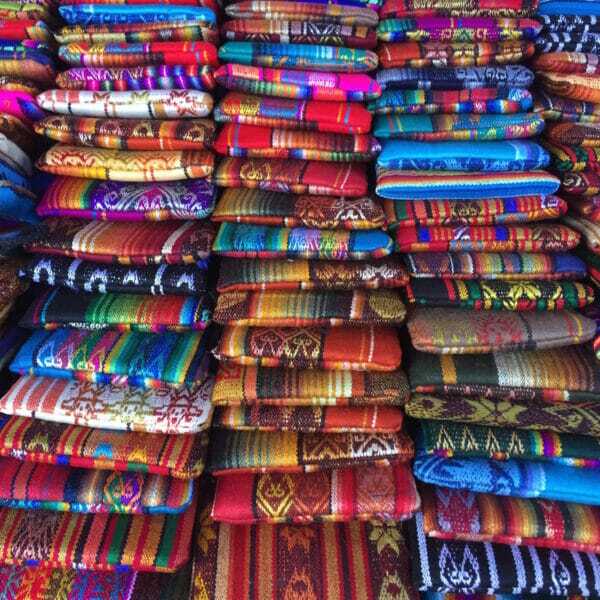
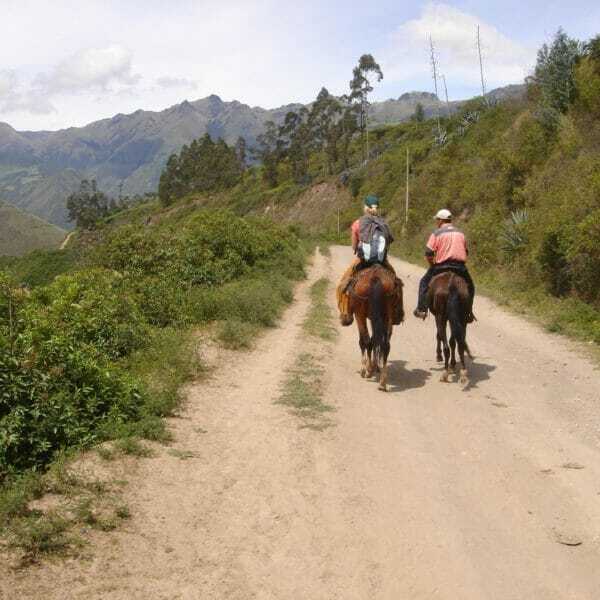
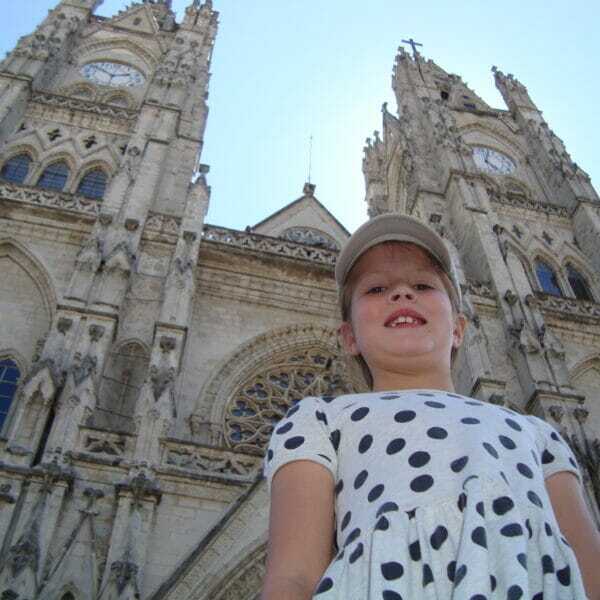
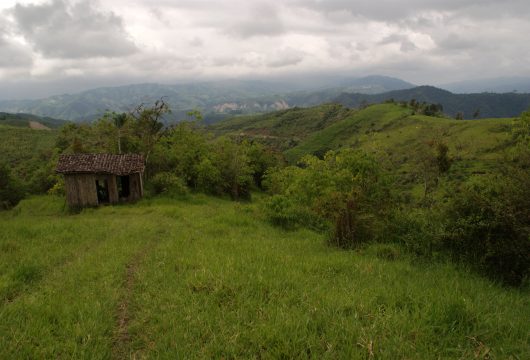
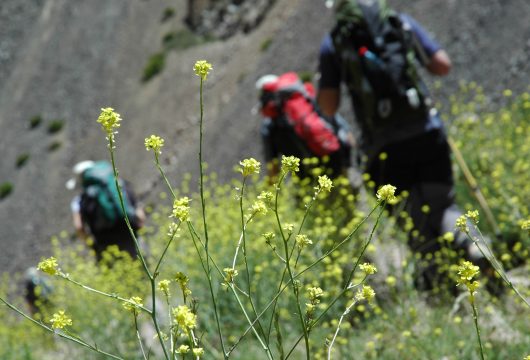
 a Tailor Made Tour
a Tailor Made Tour 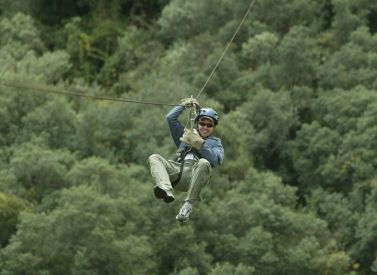
 a Group Tour
a Group Tour 